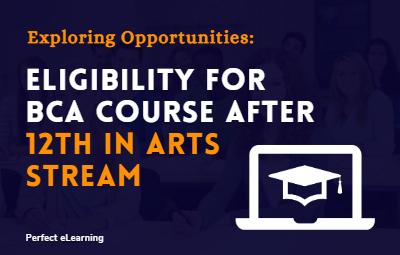

In today's rapidly advancing digital world, technology plays a crucial role in every aspect of our lives. As students graduate from high school, they face numerous opportunities and career choices. While the science and commerce streams have traditionally been associated with technology-related courses, the arts stream should not be overlooked. This article aims to explore the eligibility criteria for pursuing a Bachelor of Computer Applications (BCA) course after completing 12th grade in the arts stream. By understanding the requirements and opportunities available, arts stream students can make informed decisions about their academic and career paths.
Understanding the BCA Course
Before delving into the eligibility criteria, it's essential to understand what the BCA course entails. BCA is an undergraduate program that focuses on computer applications and software development. It equips students with the necessary knowledge and skills to pursue careers in the IT industry. The course covers subjects such as programming languages, database management, web development, and computer networks. Graduates of BCA have a wide range of career options, including software development, web design, system administration, and digital marketing.
Eligibility Criteria for BCA after 12th in Arts Stream
To be eligible for the BCA course after completing 12th grade in the arts stream, students need to meet certain criteria. While the general eligibility requirements for BCA apply to all streams, there are specific considerations for arts stream students. To pursue BCA, students must have completed their 12th grade from a recognized board or university. Additionally, they should have studied mathematics as a subject in their 12th grade, although some colleges may accept alternative subjects such as business mathematics or informatics practices.
Required Subjects and Marks
Apart from mathematics, arts stream students need to ensure they have taken relevant subjects during their 12th grade. While the specific subjects required may vary between colleges, it is common for BCA aspirants to have studied subjects such as English, computer science, and information practices. Moreover, students need to obtain a minimum percentage of marks in their 12th-grade examinations to be eligible for BCA admission. Generally, a minimum of 50% to 60% marks in aggregate is required, but this may vary based on the college and university.
Bridge Courses and Alternative Pathways
Arts stream students who do not meet the specific eligibility criteria for BCA can explore bridge courses or alternative pathways to enhance their eligibility. Some colleges offer bridge courses that provide foundational knowledge in mathematics and computer-related subjects. These courses can help arts stream students bridge the knowledge gap and meet the eligibility requirements for BCA. Alternatively, students can consider pursuing diploma courses or certification programs in computer applications before applying for BCA.
Entrance Exams for BCA
Many colleges and universities conduct entrance exams to assess the aptitude and knowledge of candidates applying for the BCA course. Popular entrance exams for BCA include NIMCET, IPU CET, and SET. To excel in these exams, students should familiarize themselves with the exam pattern, syllabus, and practice solving previous years' question papers. Additionally, developing problem-solving and logical reasoning skills can significantly enhance performance in these exams.
Scholarship Opportunities
Financial constraints should not hinder students from pursuing their dreams. Various scholarships are available for BCA students to alleviate the burden of tuition fees. These scholarships are offered by government organizations, non-profit foundations, and corporate entities. It is essential for students to actively search for scholarship opportunities and familiarize themselves with the application process and eligibility criteria. Applying for scholarships can significantly reduce the financial burden of pursuing a BCA course.
Career Opportunities after BCA
One of the key reasons for considering BCA after 12th arts is the vast array of career opportunities it offers. BCA graduates can find employment in various sectors, including IT companies, software development firms, e-commerce companies, banking, and finance. Some job roles include software developer, web designer, system analyst, database administrator, and digital marketer. The demand for skilled IT professionals continues to grow, presenting abundant career prospects for BCA graduates.
Conclusion
In conclusion, arts stream students have the opportunity to explore and pursue a BCA course after completing their 12th grade. By meeting the eligibility criteria, taking relevant subjects, and preparing for entrance exams, arts stream students can embark on a rewarding journey in the field of computer applications. With a range of career options, scholarship opportunities, and success stories, BCA offers a promising pathway for arts stream students interested in technology. It is essential to embrace the possibilities, leverage available resources, and make an informed decision to unlock the potential of a BCA course.
FAQs
Q. Can I pursue BCA after 12th arts without mathematics?
A. Yes, mathematics is generally required for BCA eligibility. However, some colleges may accept alternative subjects such as business mathematics or informatics practices.
Q. What are the job prospects after completing BCA?
A. BCA graduates have a wide range of job prospects, including software development, web design, system administration, and digital marketing.
Q. Are there any scholarships available for BCA students?
A. Yes, there are scholarships available for BCA students. It is advisable to research and apply for scholarships offered by government organizations, non-profit foundations, and corporate entities.
Q. Can I switch to a different field after completing BCA?
A. Yes, BCA graduates can explore different career paths based on their interests and skills. The knowledge and skills acquired during BCA can be transferable to various sectors.


